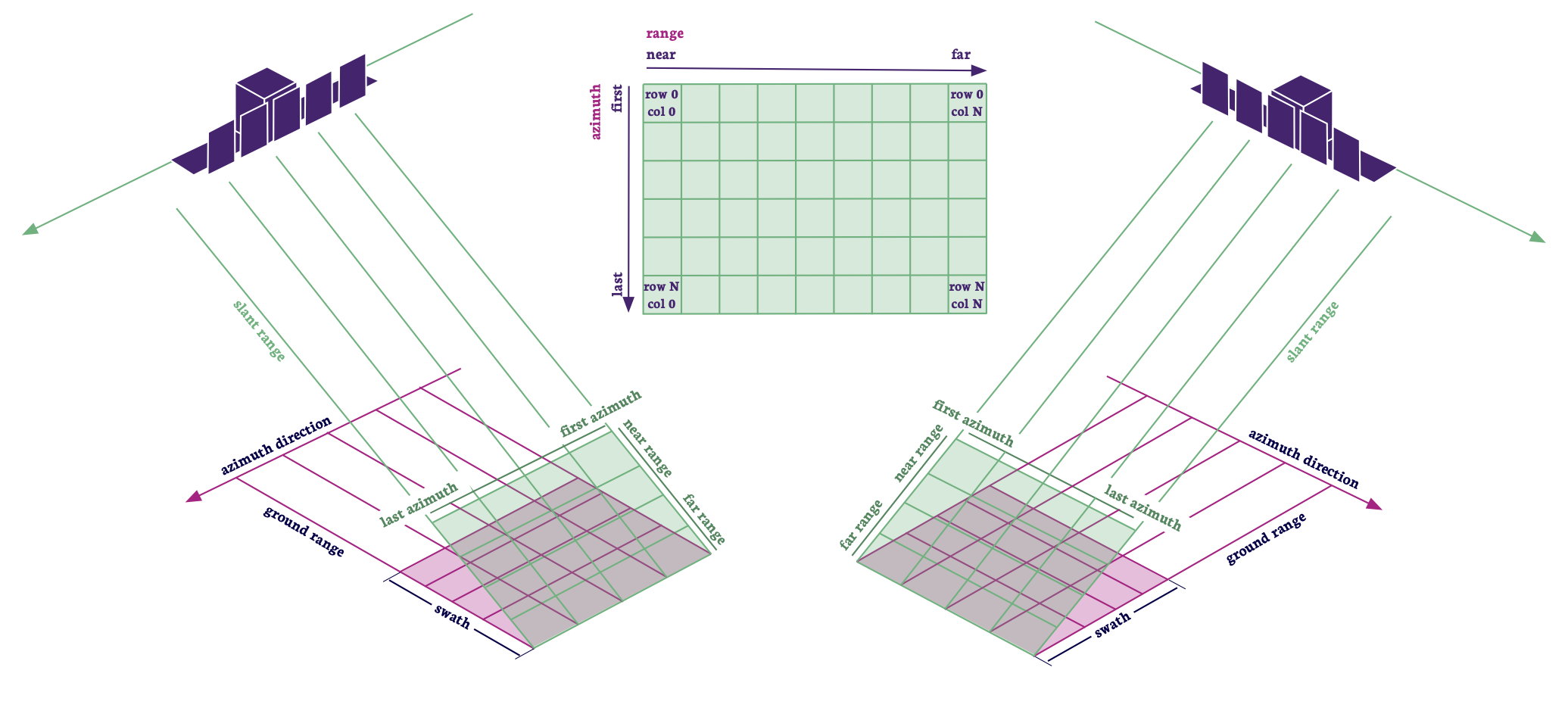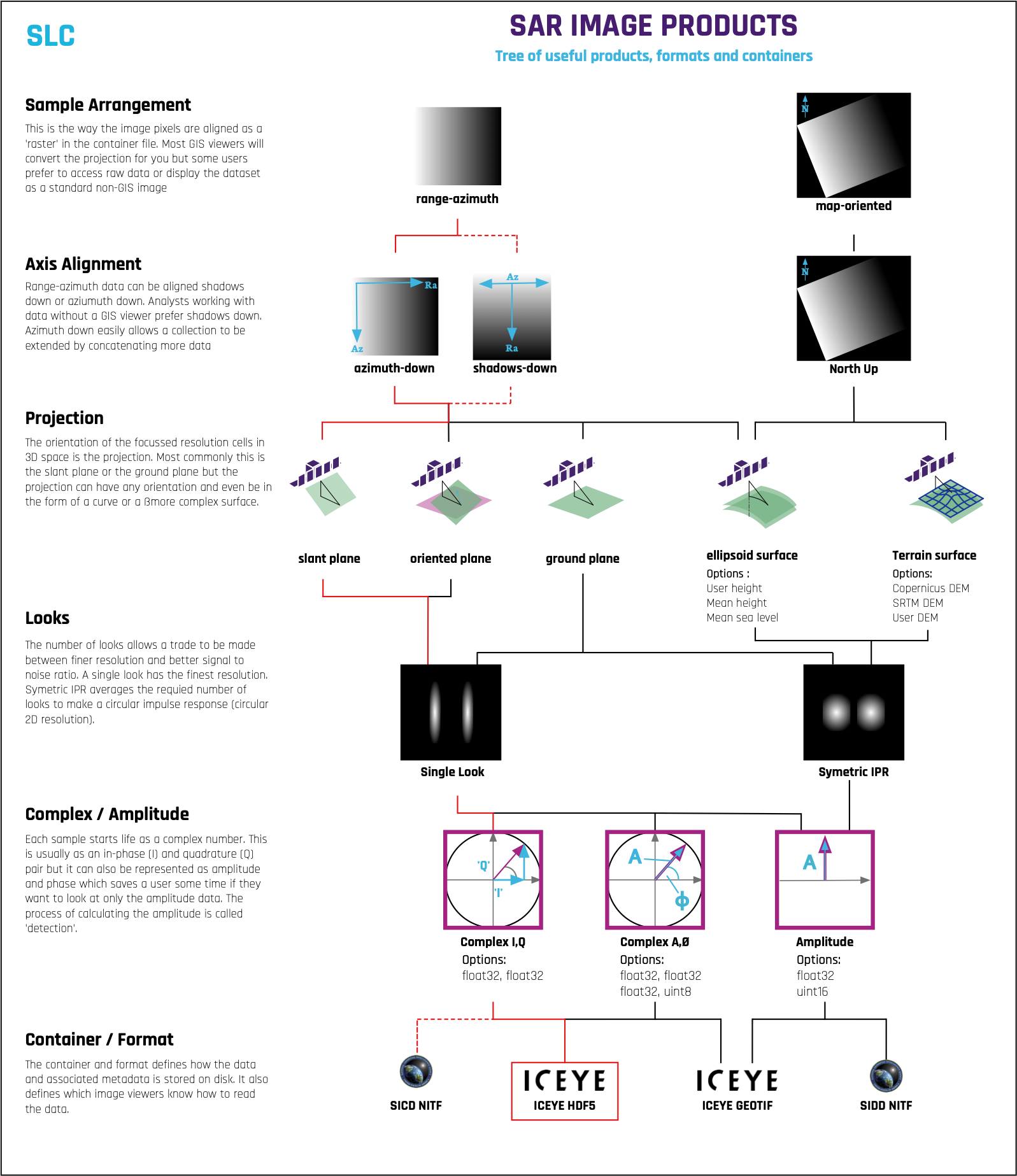Single Look Complex Image
Overview
Single Look Complex (SLC) images have the highest fidelity of all SAR image products because they are only one step removed from the original RADAR collected data. They retain all the original sensor measurements and are free from interpolation artefacts or projection issues. A small concession is made with the default SLC product in that the dynamic range of the complex numbers is reduced to make image sizes more manageable. SLC products are the best source for SAR image analysis, but complex-image exploitation software is currently difficult to use without skill and experience. For this reason, SLC images are usually used for automated processing and advanced exploitation such as interferometric applications, or by users who prefer lower-level processing in order to implement their own processing chains. The SLC product can be orthorectified using both commercial and free specialized SAR software tools such as the European Space Agency (ESA) Sentinel Application Platform (SNAP)1.
Geometry
Scenes are stored in the satellite image acquisition geometry (AKA the slant plane). The image coordinate system is centred on the zero-Doppler (time of closest approach) SAR coordinates and are arranged in the slant-range-by-azimuth imaging plane. The pixels are spaced equidistant in azimuth (according to the inverse of the pulse repetition frequency) and in slant range (according to the range sampling frequency). Each image pixel is stored with in-phase I and quadrature Q components and therefore, contains both amplitude and phase information.
Looks
As the name suggests, SLC images have only a single look. This means they retain full resolution in azimuth and range. In most cases the impulse response function (the shape of a single, isolated radar-bright object in the radar image) is asymmetrical with azimuth resolution being smaller (finer) than range resolution.
Binary Representation
SLC images are stored as binary matrices in an HDF5 file container2. Real and imaginary components are stored separately, using either signed 16 bit integers or IEEE-754 single precision 32-bit floating point format (the version used is annotated in the sample_precision metadata element). It is assumed that all pixels are valid, unless marked with a NaN (Not a Number) value.
The structure of the binary data is shown in Figure 1. Each row of the matrix is a single range line (often called a range profile by RADAR engineers) of the image with increasing range preceding from lower indices to higher indices (left to right in Figure 1). Early row indices in the matrix correspond to early pulses and later rows correspond to later pulses (top to bottom in Figure 1). It is important to recognise that image viewing software needs to take into account the matrix configuration as viewing the matrix as it is stored may result in the image being reflected in either dimension depending on right/left looking and ascending/descending.

Shadows Down
Some software algorithms prefer to process SLC imagery with increasing range aligned to increasing row index - often called shadows down orientation. This approach is usually used for fine resolution SAR imaging systems where it is important for target recognition to have a consistent shadow and layover alignment. It is often better for analysts to view SAR amplitude imagery shadows down as opposed to North-up because the human visual system prefers that orientation to properly interpret topography and elevated features. ICEYE provides SLC imagery shadows down by request. However, any image storage scheme can be manipulated on an image workstation to present images shadows down.
HDF5 Container
The SLC HDF5 container contains metadata associated with the collection in its header structure. The metadata is described in the Metadata section of this site. HDF and metadata tags can easily be found using a Python interpreter and the commands :
import h5py
f = h5py.File("<filename.h5>")
for key in f.keys():
print(f[key])
Sensor Independent Complex Data (SICD)
This is a form of complex data that is carefully designed to remove any sensor-specific parameters. SICD image data is in the same format regardless of processing algorithm or collection strategy. In theory, any algorithm that uses SICD will work on SAR imagery from any SAR vendor. The SICD specification was developed by the US National Geospatial Intelligence Agency (NGA) and it is stored in the NITF (National Imagery Transmission Format[@nitf) container. For this reason, SICD files can only be used with GIS viewers and algorithms that know how to handle this type of dataset. Since NITF is not as well known as hdf5, the SICD product is currently only available from ICEYE by request.
SLC in Context
Figure 2 provides a useful summary of SLC images in the context of the processing options available with the red line highlighting the decisions made during product production.
References
-
European Space Agency. The sentinel application platform - snap. Accessed 2020 Dec 17. URL: http://step.esa.int/main/toolboxes/snap/. ↩
-
The HDF Group. The hdf5 library & file format. Accessed 2020 Dec 17. URL: https://www.hdfgroup.org/solutions/hdf5/. ↩
